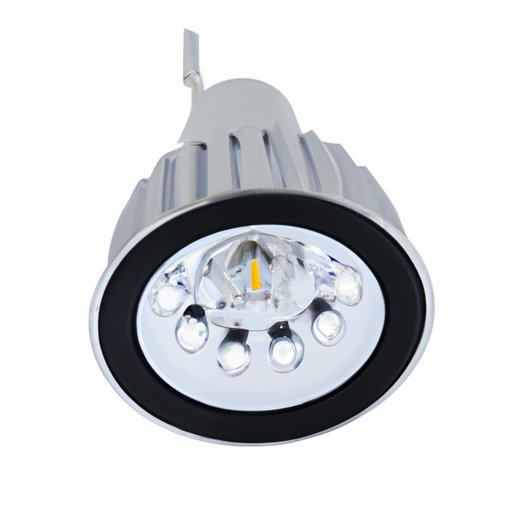Introduction
Can lights, also known as recessed lights, are a popular choice for ceiling lighting. They are versatile and energy efficient, making them ideal for both residential and commercial applications. But what exactly are can lights and how do they work? In this comprehensive guide, we’ll explore the basics of can lights, how to install them in ceilings, the pros and cons of using them, different types of can lights, and creative ideas for decorating with them.
DIY Guide to Installing Can Lights in Ceilings
Installing can lights in ceilings is a relatively straightforward process that can be done by most DIYers. Here’s what you’ll need:
- Can lights
- Recessed lighting housing
- Light bulbs
- Power drill
- Wire strippers
- Fish tape
- Screwdriver
Once you have all the necessary tools and materials, here’s a step-by-step guide on how to install can lights in ceilings:
- Turn off power and remove existing fixtures.
- Check the ceiling joist spacing and mark the locations for the can lights.
- Drill holes for the can lights and insert the recessed lighting housings.
- Run the electrical wiring from the power source to the can light housings.
- Connect the wires to the can light housings and mount them securely in the ceiling.
- Install the trim and light bulbs.
- Turn the power back on and test the lights.
Pros & Cons of Using Can Lights in Ceilings
Can lights offer many advantages when it comes to lighting up a room. Here are some of the benefits of using can lights in ceilings:
- They provide directional lighting, which is great for task lighting.
- They don’t take up any space in the room, allowing for more flexibility when it comes to furniture placement.
- They’re easy to install and maintain.
- They offer energy efficiency and cost savings over time.
However, there are also some potential drawbacks to consider when installing can lights in ceilings:
- They can be difficult to access if repairs or maintenance is needed.
- They may not provide enough overall illumination for some rooms.
- They can cause glare in certain situations.
Different Types of Can Lights and How They Affect Lighting Design
When choosing can lights for your ceiling, it’s important to understand the different types of can lights and how they affect lighting design. The three most common types of can lights are halogen, LED, and incandescent.
Halogen Can Lights
Halogen can lights provide bright, white light and are great for task lighting. However, they produce a lot of heat and can be expensive to operate.
LED Can Lights
LED can lights offer energy efficiency and long life spans. They also provide a range of color temperatures, making them ideal for accent lighting.
Incandescent Can Lights
Incandescent can lights are the least energy efficient type of can light, but they provide warm, inviting light and are usually the least expensive option.
Top Tips for Choosing the Right Can Lights for Your Ceiling
When selecting can lights for your ceiling, there are a few things to keep in mind. Here are some tips to help you choose the right can lights for your needs:
- Consider the size and layout of the room. This will help you determine how many can lights you need and where they should be placed.
- Determine the desired brightness. Different types of can lights provide different levels of brightness, so pick one that best suits your needs.
- Think about energy efficiency. LEDs offer the highest level of energy efficiency, but they can be more expensive than other types of can lights.

How to Choose the Right Placement for Can Lights in Your Ceiling
Once you’ve chosen the right type of can lights for your ceiling, it’s important to think about the placement of the lights. Here are some tips for choosing the right placement for your can lights:
- Consider the usage of the room. Where will people be spending most of their time? You want to make sure the can lights are placed in areas where they’ll be used most.
- Take measurements. Measure the length and width of the room to ensure that the can lights are evenly spaced.
- Find the right balance. You don’t want too much or too little light, so try to find a balance between the two.

The Benefits of Upgrading to LED Can Lights in Your Ceiling
Upgrading to LED can lights in your ceiling offers a number of benefits. Here are a few of the advantages of upgrading to LED can lights:
- Lower electricity costs. LED lights use less electricity than other types of can lights, resulting in lower electricity bills.
- Improved lighting quality. LED lights provide brighter, more natural-looking light than other types of can lights.
- Longer lifespan. LED lights last longer than other types of can lights, so you won’t have to replace them as often.

Creative Ideas for Decorating with Can Lights in Ceilings
Can lights don’t just have to be functional; they can also be a great way to add a decorative touch to your ceiling. Here are some creative ideas for decorating with can lights in ceilings:
- Colorful filters. Add a pop of color to your ceiling with colored filters for your can lights.
- Accent lighting. Use can lights to highlight artwork or create a cozy atmosphere in a room.
- Dimming controls. Install dimmer switches to adjust the brightness of your can lights.
Conclusion
Can lights are an excellent choice for ceiling lighting because they are versatile, energy efficient, and easy to install. With the right type of can lights and proper placement, you can create a beautiful lighting design in any room. Upgrading to LED can lights can also provide additional energy savings and improved lighting quality. Finally, don’t forget to get creative with your can lights by adding colorful filters, accent lighting, and dimming controls.


